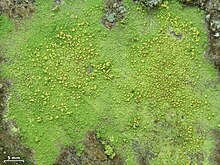
Flavoparmelia baltimorensis, the rock greenshield lichen, is a medium to large foliose lichen with a yellow green upper thallus surface when dry; its lobes are rounded without pseudocyphellae; and the upper surface is covered with globose, pustule-like growths resembling isidia. The lower surface is black with a narrow brown zone at the margins.
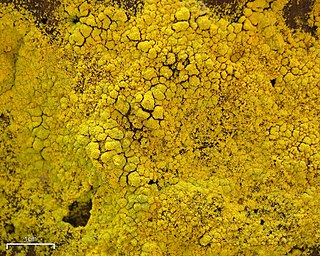
Chrysothrix candelaris, commonly known as the mustard powder lichen or gold dust lichen, is a species of leprose (powdery) lichen in the family Chrysothricaceae. It typically grows on tree bark, although it has also been recorded growing on rock. It does not show ascocarps or other reproductive structures, belonging to the group commonly known as the 'Fungi or lichens imperfecti' in the UK.

Acarospora is a genus of lichenized fungi in the family Acarosporaceae. Most species in the genus are crustose lichens that grow on rocks in open and arid places all over the world. They may look like a cobblestone road or cracked up old paint, and are commonly called cobblestone lichens or cracked lichens,. They usually grow on rock, but some grow on soil (terricolous) or on other lichens. Some species in the genus are fungi that live as parasites on other lichens. Acarospora is a widely distributed genus, with about 128 species according to a 2008 estimate.
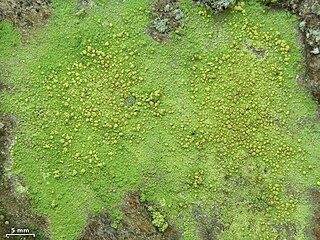
Psilolechia is a genus of four species of crustose lichens. It is the only member of Psilolechiaceae, a family that was created in 2014 to contain this genus.

Micarea is a genus of lichenized fungi in the family Pilocarpaceae. The widely distributed genus contains 126 species and new species are described actively. Species in the genus are crustose lichens and their photobiont is a single-celled green alga.
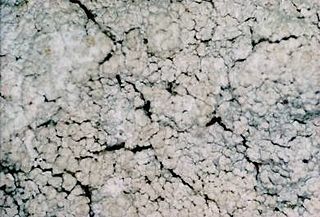
Lepraria is a genus of leprose crustose lichens that grows on its substrate like patches of granular, caked up, mealy dust grains. Members of the genus are commonly called dust lichens. The main vegetative body (thallus) is made of patches of soredia. There are no known mechanisms for sexual reproduction, yet members of the genus continue to speciate. Some species can form marginal lobes and appear squamulose. Because of the morphological simplicity of the thallus and the absence of sexual structures, the composition of lichen products are important characters to distinguish between similar species in Lepraria.

Chrysothrix is a genus of lichen-forming fungi in the family Chrysothricaceae. They are commonly called gold dust lichens or sulfur dust lichens, because they are bright yellow to greenish-yellow, sometimes flecked with orange, and composed entirely of powdery soredia. Apothecia are never present in North American specimens.

Lobaria scrobiculata, commonly known as the textured lungwort, is a large foliose, epiphytic lichen in the family Peltigeraceae.

Crustose lichens are lichens that form a crust which strongly adheres to the substrate, making separation from the substrate impossible without destruction. The basic structure of crustose lichens consists of a cortex layer, an algal layer, and a medulla. The upper cortex layer is differentiated and is usually pigmented. The algal layer lies beneath the cortex. The medulla fastens the lichen to the substrate and is made up of fungal hyphae. The surface of crustose lichens is characterized by branching cracks that periodically close in response to climatic variations such as alternate wetting and drying regimes.
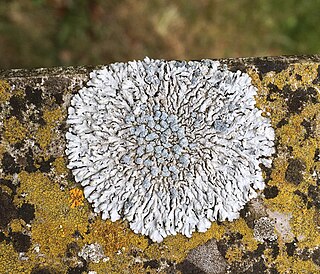
Physcia caesia, known colloquially as blue-gray rosette lichen and powder-back lichen, is a species of foliose lichenized fungus. First described by Georg Franz Hoffmann in 1784, it is common across much of Europe, North America and New Zealand, and more patchily distributed in South America, Asia, Australia and Antarctica. There are 2 subspecies: P. c. caesia and P. c. ventosa, as well as a number of distinct forms and varieties. Molecular studies suggest that the species as currently defined may be polyphyletic. It is typically pale gray shading to darker gray in the center, and grows in a small rosette, usually some 2–3 cm (0.79–1.18 in) across at maturity. It only rarely has apothecia, instead reproducing most often vegetatively via soredia, which are piled in round blue-gray mounds across the thallus's upper surface. It grows most often on rock—principally calcareous, but also basaltic and siliceous—and also occurs on bone, bark and soil. It is nitrophilic and is particularly common on substrates where birds perch.

Punctelia graminicola is a species of foliose (leafy) lichen in the family Parmeliaceae. It grows on rocks, and, less frequently, on bark in North America, South America, and East Africa. It has a blue-grey thallus measuring up to about 15 cm (6 in), covered with tiny pores called pseudocyphellae. Sometimes the lichen forms small lobes that project out from the surface. Fruiting bodies are uncommon in this species; if present, they resemble small cups with a brown internal disc measuring 3–10 mm (0.1–0.4 in) in diameter. A lookalike species, Punctelia hypoleucites, is not readily distinguishable from Punctelia graminicola by appearance or habitat alone; these species can only be reliably differentiated by examining the length of their conidia.

Lepraria incana is a species of dust lichen in the family Stereocaulaceae. First described scientifically by Johann Jacob Dillenius in 1741, and then formally by Carl Linnaeus in 1753, it is the type species of the genus Lepraria. The thallus of this species is green to greyish-green, and powdery – as if made of tiny granules. These granules are soredia, which are asexual reproductive structures. Like most members of genus Lepraria, the lichen has few distinguishing features, lacking both a medulla and sexual reproductive structures (apothecia). Chemically, the lichen is characterised by the presence of the secondary chemicals known as divaricatic acid and zeorin.

Ochrolechia africana, commonly known as the frosty saucer lichen, is a species of crustose and corticolous (bark-dwelling) lichen in the family Ochrolechiaceae. It is a widely distributed species, found in tropical and subtropical areas of southern Africa, Asia, Australia, North America, and South America. The lichen is characterized by the presence of a white "frosty" or powdery apothecia.

Chrysothrix flavovirens is a species of crustose and corticolous (bark-dwelling) lichen in the family Chrysotrichaceae. It was formally described as a new species in 1994 by Tor Tønsberg as the sorediate counterpart of the common and widespread Chrysothrix candelaris. The type specimen was collected from Kirkeøy, Norway, where it was found growing on Picea abies. It has a pale greenish-yellow thallus that contains rhizocarpic acid. The lichen is widespread in Europe, and has also been recorded from Japan and North America. In the Atlantic and Mediterranean biogeographic regions of Portugal, it prefers to grow on the acidic bark of coastal conifer trees.
Loxospora cristinae is a fungal species classified in 2018, found in a few European countries. It belongs to the division Ascomycota and the family Sarrameanaceae. It was first identified and described in the 19th century, but the species would not be correctly classified until almost two centuries later. Loxospora cristinae is a sterile crustose lichen, meaning it reproduces by a type of vegetative spore that has evolved specifically to produce morphological structures.
Micarea pauli is a species of corticolous and lignicolous, crustose lichen in the family Pilocarpaceae. It is only known to occur in Poland's Białowieża Forest.
Bacidina mendax is a species of corticolous (bark-dwelling) lichen in the family Ramalinaceae. It is found in Central and Eastern Europe, where it grows on the bark of twigs and tree branches.
Inoderma sorediatum is a species of crustose lichen in the family Arthoniaceae. It is only known to occur on the bark of trees in Poland's Białowieża National Park. It is differentiated from other species in genus Inoderma by the form of its thallus, which is entirely made of powdery, granular soredia, as well as by the presence of a unique combination of lichen products.

Bacidina pycnidiata is a species of crustose lichen in the family Ramalinaceae. It is widely distributed in Europe and North Asia. It is characterised by its whitish or cream-coloured pycnidia with long and ostiolar necks.
Astrothelium pallidoflavum is a species of corticolous (bark-dwelling) lichen in the family Trypetheliaceae. Found in Bolivia, it was formally described as a new species in 2016 by lichenologists Adam Flakus and André Aptroot. The type specimen was collected from Noel Kempff Mercado National Park at an altitude of 220 m (720 ft); there, in a Beni savanna with trees, the lichen was found growing on bark. It is only known to occur at the type locality. The species epithet refers to the characteristic pale yellow colour of the pseudostromata. Astrothelium pallidoflavum is similar to A. cinnamomeum, but has larger ascospores than that species.
